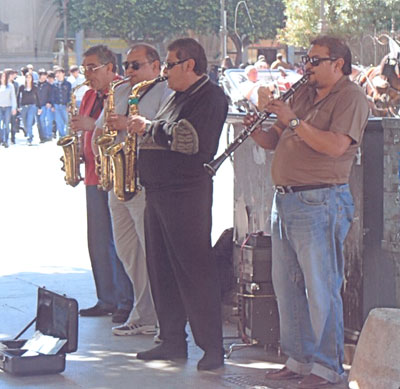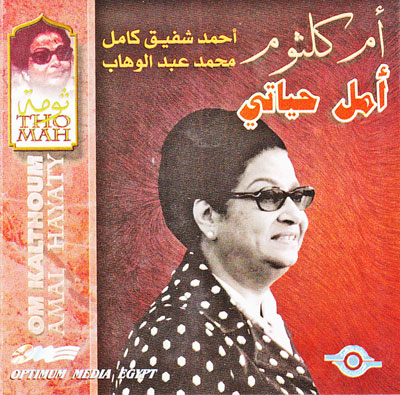Music! Music! Music!
While traveling outside of the US, have you bought a CD of music typical of the country or area? A recording of the Berlin Philharmonic while you were in Germany, perhaps? Or maybe a CD of a street performer? For those of you who did, we asked that you tell us about the music and the artist plus any advice on making purchases. Responses were printed in last month’s issue, and more appear below.
If you have something to add, write to Music! Music! Music!, c/o ITN, 2116 28th St., Sacramento, CA 95818-1910, or e-mail editor@intltravelnews.com. Include the address at which you receive ITN and state approximately when you made the trip.
I always try to buy music of the country I am visiting. At first it was on cassettes and now it’s on CDs. I buy them at street stalls, temples, churches, museums and, occasionally, music stores.
My most successful purchases have been at temples, churches and museums where music that I liked was playing. I would ask someone if I could buy that music; frequently, I could.
I have also bought CDs from singers performing in churches in Russia and after performances in cathedrals in England.
At street stalls and in music stores, I usually go by genre, trying to find music similar to something I have heard on the streets or wherever. If there is a wide choice of CDs, I go by the picture. I usually have no idea of who the artists are, but in India I have inadvertently purchased music by artists I later discovered to be quite famous.
I like the chance element involved in these purchases. I have never brought home something horrible, but there are CDs I listen to more often than others.
The staff in music stores are often good guides, and I follow their suggestions when they make them.
Terrence Johnson
Los Angeles, CA
The question in the publisher’s August ’11 “Departure Lounge” column was, “Have you ever bought a CD of the music of a country you were in?” A more apt question might be, “Have you ever NOT bought a CD…?” I’ve purchased CDs from musicians from South Africa to Ukraine and from Argentina to Germany.
One group in Sicily was particularly memorable: the Benny Group, four middle-aged guys — three on saxophone and one on clarinet — happily honking away in Palermo.
Street players’ CDs reflect a unique kind of entrepreneurial sincerity and appealing musicianship. Buying a CD soon after arriving in a new country provides an immediate sense of the place, musically speaking.
My wife and I drove through Sicily in April-May ’08 enjoying the funky sounds of the Benny Group.
Norm Leaper
San Francisco, CA
In 1999 we went with MIR Corp. on a Trans-Siberian Railroad journey from Moscow to Beijing along the ancient tea route. What a trip! When we got to Ulan Bator, Mongolia, they arranged for us to enjoy a performance of Tuvan throat singers — fantastic! We enjoyed the show and music of the group Altain Orgil and bought a CD.
We still play the CD for our enjoyment.
Nick & Kathryn Walters
Roswell, NM
In Tibet in 2002, I purchased a CD of Tibetan music which I then put into iTunes for my slide show. The music, with its unusual instruments, sounds ethereal. I find it so relaxing that I listen to it when I’m in traffic; I can feel my frustration just ebb away. (Unhelpfully, the title is “Music from China Tibet,” with the rest in Chinese characters.)
At the 1993 Cork Jazz Festival in Ireland, I bought the CD “Beer Goggles and Funky Juice” by the Bogus Brothers. They’re “bogus” because they record mostly other people’s music (there’s one original song on the CD). I just love the instruments — lots of brass.
In Italy in 1998, I discovered Zucchero Sugar Fornaciari and bought “Oro Incenso & Birra” — classic rock.
Phyllis Bismanovsky
Mountain View, CA
My husband and I buy music (CDs now but actual vinyl in the old days) when we travel. We have quite a collection from over the years, including Croatian, Turkish, Scottish, Irish, English country dance and Argentine tango, but two are our favorites.
On a Spain visit in May 2005, we walked down a narrow cobblestone street in Santiago de Compostela on a lovely, sunny afternoon. From the open doorway of a tiny gift shop floated strains of folk music — fiddle, drums and bagpipes. Surprised to hear Irish (or was it Scottish?) music in Spain, we stepped into the shop and inquired. It turns out that the region of Galicia in Spain is Celtic!
We bought two CDs of the not-quite-Irish-or-Scottish-but-definitely-not-Spanish music: “Viaxe por Urticaria” by Berroguetto, published in 1999 by BOA Music, and “A Galicia de Maeloc” by Milladolro, published in 1990 by Dial Discos.
In Germany, the castle Burg Satzvey (An der Burg 3, D-53894 Mechernich-Satzvey, Germany; phone + 49 [0] 2256-95 830, fax 95 83 77) holds a medieval festival every year over several weekends in September, and they really go all out — food, tournaments, strolling magicians and stilt walkers.
For 10 days, people live on the grounds of the castle in tents, cooking over open fires and wearing leather and homespun clothing (although they do have the modern sanitation of porta-potties). And the music!
At this festival, we’ve heard the group Schelmish play music from the Middle Ages using huge drums, bagpipes and stringed instruments. In 2010 we bought their CD “Igni Gena” (roughly translated from Middle Ages German, that means “born of fire”), recorded by Sven Neumann KlangFabrique. Our bonus? Hearing Schelmish’s medieval cover of the June Carter/Merle Kilgore song “Ring of Fire,” made famous by Johnny Cash. What a hoot!
The castle also hosts a medieval Christmas market in December and a witches market in May.
Martha Wiley, Landstuhl, Rheinland-Pfalz, Germany
A CD called “Uzbek National Classic Music — Melodies of Rubob” came from Uzbekistan and introduced us to their heritage of sound. It is performed by makam players “Turghun Ashmator, Tokhir Rajabi, Abdukhoshim Ismoilov, Aki.”
They play folk music on the tambur, dutar, rabab, ghijjak, chang, kanoon, ud, nay, tor, daira, karnay, surnay and kushnay. Most of these are string instruments, with some wind and some percussion.
Referred to on the CD are “Bobumurod” and “Bobur” at Sherdor Medresse Music Instruments Workshop, Registan Square, Samarkand.
Nanci Micklon
Fayettevllle, NY
While on a Zegrahm Expeditions cruise of Melanesia in 2009, our ship, the Clipper Odyssey, stopped at one of the islands of Vanuatu — really remote.
We were greeted by live musicians and I bought their CD. It is “UNIty” by the Baton Local String Band, and I dare anyone to listen to it and not start to smile and dance.
It’s more hoedown than symphony and I play it at least once a month, remembering my trip.
Karen Carlson
Corona del Mar, CA
Her music may sound strange to Western ears and her singing may be an acquired taste, but, born in a humble village on the Nile Delta as the daughter of a local imam, Um Kulthum — known as Kawkab el-Sharq, or Star of the East — became the most popular and famous singer in the Muslim world, especially during her heyday in the 1940s and early ’50s.
Classified as a contralto, Um Kulthum (aka Om Kalsoum, Oumme Kalsoum and Umm Kolthoum) was noted for her powerful voice, her voice control, her wide vocal range, covering several octaves, and her virtuosic performances that often lasted three to four hours. She acquired status as a diva and a highly sophisticated celebrity and star.
Most of all, she is noteworthy for her unique blend of music, poetry and intense emotion. Singing about love, loss, longing, the glories of Egypt and the Muslim faith, she had the uncanny ability of establishing an emotional bond with her audiences.
Um Kulthum came to my attention in a short article in my Knopf guide on Egypt, and on a tour there in September 2003 I found it very easy to locate a CD of her music at a small stall in one of the souks of Cairo for $10-$15 in Egyptian pounds.
Along with a “tree of life” painting on papyrus, a small alabaster vase and a small obelisk of malachite, my Um Kulthum audio disc remains one of my treasured souvenirs from my trip to Egypt.
David J. Patten
St. Petersburg, FL
In 1999 I attended the Rainforest World Music Festival, which is held in August each year at the Sarawak Cultural Village near Kuching City in Sarawak, Malaysia.
The cultural village was a perfect venue, with multiple locations in the various longhouses for small classes and jam sessions plus a large central area with a stage where evening performances were held.
During the three-day festival, I heard music from Cuba, Peru, Madagascar, China, Indonesia, Malaysia and (stretching the definition of “rainforest” to the breaking point) Scotland.
Each day, musicians held workshops for festival attendees, comparing drumming styles; wind instruments; guitars, sitars and lutes; women vocalists, etc. The universal language of music triumphed over the lack of translators.
Most exciting were the times at the end of the workshops when the musicians all would play a song together. Each group would take turns embroidering the song with their particular techniques. It was magical.
One of the main stringed instruments used in Sarawak music is the sape (which sounds almost like a banjo). I purchased two CDs: “Masters of the Sarawakian Sape” by Tusan Padan (who had held a concert and workshop for us) and “Sawaku: Music of Sarawak” by various artists. The CDs cost $7 each and, at the park entrance, were sold on a table that held samples from all the performing groups.
Its songs remind me of hearing the rain falling gently on the roof of the longhouse as we listened to the rise and fall of Padan’s melodies matching the rain.
Mary Beltran, ITN


